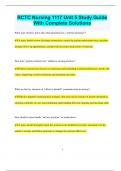RCTC Nursing 1117 Unit 5 Study Guide
With Complete Solutions
What steps should a nurse take when preparing for a "patient discharge"?
✔✔A nurse should review discharge instructions, ensure the patient understands their care plan,
arrange follow-up appointments, and provide necessary medications or referrals.
How does "patient-centered care" influence nursing practices?
✔✔Patient-centered care focuses on respecting and responding to patient preferences, needs, and
values, improving overall satisfaction and treatment outcomes.
What are the key elements of "effective handoff" communication in nursing?
✔✔Effective handoff communication includes clear and concise transfer of patient information,
ensuring continuity of care, and confirming understanding between outgoing and incoming staff.
How should a nurse handle "adverse reactions" to medications?
✔✔A nurse should promptly report the reaction to the healthcare provider, document it in the
patient’s records, and follow protocols to manage the reaction effectively.
1
,What is the purpose of "care coordination" in nursing?
✔✔Care coordination ensures that all aspects of a patient’s care are organized and integrated,
improving efficiency and reducing the risk of errors.
How does "evidence-based practice" impact nursing care?
✔✔Evidence-based practice involves using the best available research and data to inform clinical
decisions, improving patient outcomes and care quality.
What strategies can be employed to "manage patient anxiety" during procedures?
✔✔Strategies include providing clear explanations, offering reassurance, using calming
techniques, and addressing any patient concerns or questions.
How should a nurse assess "nutritional needs" for a patient?
✔✔A nurse should evaluate the patient’s dietary habits, medical history, and current health
status, and collaborate with a dietitian to create an appropriate nutrition plan.
What role does "team collaboration" play in patient care?
✔✔Team collaboration enhances patient care by leveraging the diverse expertise of healthcare
professionals, leading to more comprehensive and effective treatment plans.
2
,How can "self-care" be promoted among patients in a nursing setting?
✔✔Self-care can be promoted by educating patients about their health conditions, encouraging
independence, and providing resources and support to manage their health effectively.
What is the importance of "patient consent" before performing medical procedures?
✔✔Patient consent ensures that the patient is informed about the procedure, understands the
risks and benefits, and agrees to the treatment, respecting their autonomy and legal rights.
How does "nurse-patient rapport" affect care delivery?
✔✔Building a strong nurse-patient rapport fosters trust and open communication, leading to
better patient cooperation and improved care outcomes.
What are "critical indicators" to monitor for in a patient with cardiovascular issues?
✔✔Critical indicators include blood pressure changes, heart rate abnormalities, signs of chest
pain, and oxygen saturation levels.
How should a nurse address "cultural differences" in patient care?
3
, ✔✔A nurse should recognize and respect cultural differences, tailor care plans to accommodate
these differences, and communicate effectively with sensitivity to cultural practices.
What is the role of "preventive care" in nursing?
✔✔Preventive care involves measures taken to prevent illness or injury, such as vaccinations,
screenings, and health education, to maintain overall health and well-being.
How does "patient mobility" influence recovery and rehabilitation?
✔✔Encouraging patient mobility supports recovery by improving circulation, reducing muscle
atrophy, and preventing complications such as pressure ulcers.
What is the purpose of "patient advocacy" in nursing?
✔✔Patient advocacy involves supporting and representing the patient’s interests and needs,
ensuring their voice is heard and their rights are protected within the healthcare system.
What are the "signs of infection" that a nurse should monitor for?
✔✔Signs of infection include fever, redness, swelling, increased pain, and discharge at the site
of infection.
4




